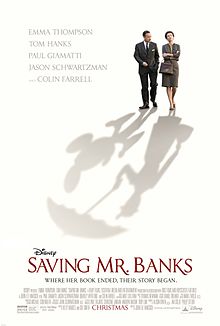
An American-British-Australian production, Saving Mr. Banks is a comedy-drama-biopic that tries to satisfy the audience by sweetening history, whilst providing a sense of accuracy via dramatized facts. The result is that much like the P. L. Travers character, Saving Mr. Banks' emotionally conflicted protagonist, the film itself ends up being uneven. Directed by John Lee Hancock to a screenplay by Kelly Marcel and Sue Smith, Saving Mr. Banks focuses on Walt Disney Studios' 1964 production of Mary Poppins, an ordeal challenged by Disney's disagreement with P. L. Travers, Mary Poppins' author, with respect to the production team's creative freedom.
Noteworthy elements that work in this film include the creation of an authentic feeling for the time at which the events took place; brilliant performances by Emma Thompson as P. L. Travers, and by Colin Farrell as Travers Robert Goff. Travers Goff, the author's alcoholic and ill-tempered father, much loved his daughter and played an inspiring role in her life, encouraging her imagination. Notable are also Tom Hanks as Walt Disney, Paul Giamatti as the driver, and most of the other supporting cast members. Kudus go also to the art direction and cinematography.
On the downside, Saving Mr. Banks intercuts between the film's then-current time (1961) and P. L. Travers' childhood, a period which, no doubt, greatly affected her later writings. While the inserts from the past would make complete sense in a written format, somehow it does not work well on the big screen. I would almost prefer to see each period on its own rather than being taken back and forth like being on a wild Disney park ride. Furthermore, P. L. Travers was a complex and interesting character which, in this film, due to no fault of Emma Thompson, comes across as a confused and neurotic persona, one that acts on a whim with motivation based on anxiety rather than any perceived logic. Walt Disney is presented more kindly than the stories about him portray; and even though the filmmakers claim to have not been pressed by the Disney Studios for a favorable treatment, it sure does feel that way.
All in all, at over two hours long, Saving Mr. Banks feels longer than the sum of its parts. It disappoints in its superficiality versus the story's potential, a classic case where some Poppins magic would have saved the day.